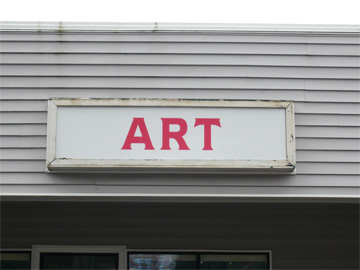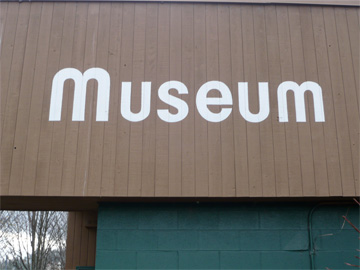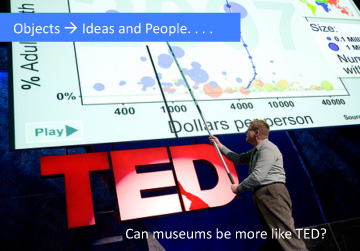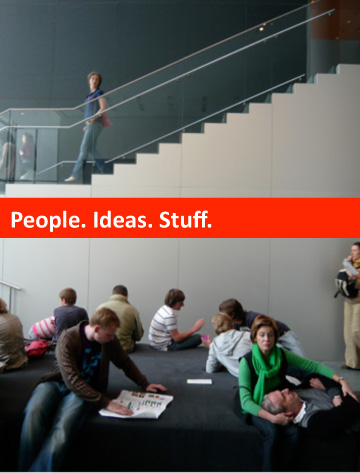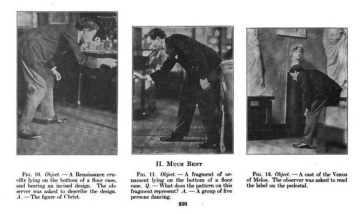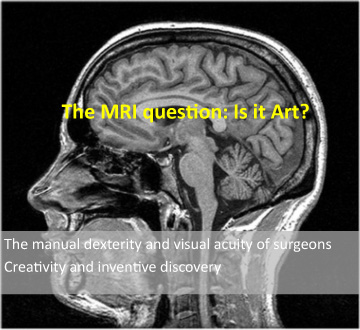In the next two weeks, museum leaders gather in two places—art curators in New York May 15-17 and everyone in Houston May 22-25—to contemplate the future of the field. How do these conversations affect all of us, and what is possible for museums as very specific stewards of the very broad category of imagination and creative thinking?
I would like to posit that what museums need to do next is not to continue one of the greatest building booms in their history but to redefine art. Instead of being reservoirs for objects, they need to be platforms—part think tank, part school—for conversations about creativity across fields not just about the appreciation of creativity within the arts.
Right now, one place people go when they want to experience wonder in great works of imagination is not museums but TED—short for Technology, Entertainment, Design—the conference that started as a single event in 1984 and then grew into its current constellation of annual gatherings, each a program of 18-minute talks devoted to “ideas worth spreading.” Since TED talks first appeared online in 2005, about 300 million people have watched them.
As TED’s mission statement begins, “An idea can be created out of nothing except an inspired imagination. An idea weighs nothing. . . . And yet an idea, when received by a prepared mind, can have extraordinary impact.. . .”
The power of creative thinking is the ultimate disruptive technology to the physical footprint of art museums and the collections they house. It is exactly at the delicate peak of a sustained building boom that museums must shift their focus from the monumental weight of buildings to the ephemeral power of ideas.
An unrelenting building boom and connoisseur-hoarder mentality has characterized the museum field. Fifty years ago, then Art Editor of The Saturday Review, Katharine Kuh, coined the term “edifice complex” to describe the arms race to have ever larger and more beautiful buildings. (From “What Should a Museum Be?” Art in America, 1961, in an addendum titled “Minus of the Building Boom”–worth looking up at the library to read the whole set of essays.)
That race continued unabated up through this year’s new wing of the Boston MFA, to the likely, if posthumous, consternation of people like Margaret Talbot Jackson, who proclaimed as early as 1917 that specifically large museums would go the way of the dodo bird because it would be too overwhelming “to the weary visitor who knows that although he is now in gallery number 22, there are fifty-seven that he has not seen, and through which he possibly may have to pass before emerging from the building.” [from Margaret Talbot Jackson, The Museum: A Manual of the Housing and Care of Art Collections (London: Longmans, Green and Co., 1917), 8.]
As Benjamin Ives Gilman, the longtime secretary of Museum of Fine Arts Boston, points out a year later in 1918, “Intrinsically, the history of art has no more claim upon the attention of the intelligent public than has the history of religion or of science or of government or of any other special element of civilization.” (from Benjamin Ives Gilman, Museum Ideals of Purpose and Method, 1918. Cambridge, Mass: Riverside, 105. You can read the whole book on Google.) Gilman devoted a whole chapter of the book to wicker stools as cures for museum fatigue, and used to take fantastic pictures of men looking at artworks hung at the wrong height:
Rewriting the story of museums’ futures is an editorial task, and as Annie Dillard says of editing in The Writing Life, “it is often a bearing wall that has to go.” The load-bearing wall here is a focus on buildings and objects instead of on people and ideas.
Imagine a world in which business leaders meet for breakfast at the museum—inviting in writers on innovation. Imagine if MoMA invited medical conferences meeting down the street at the New York Hilton to use its movie theaters in the morning, the occasional curator sitting in. Picture regional museum directors seeking out scientists at their local academic institutions and asking them what advances they most admire in their fields.
Imagine what could happen if museums succeeded in finding points of connection with people outside the arts—with the visual acuity of surgeons and the “blank canvas” triumphs of entrepreneurs and the innately human creativity of everyday life, Halloween costumes, spontaneous wit and all.
Like TED, museums could spark a conversation that arcs into many fields, that makes them anchors in larger social processes of reinvention and recovery, economically and otherwise. It is the bridge span of those conversations that will support the great museums of tomorrow.
Postscript:
I just published a separate piece on museums in the journal ArtWrit, on the question: Does It Still Make Sense to Build a Museum? The piece draws more on my experience planning the William Eggleston Museum in Memphis.
As a hint at the ArtWrit piece, I’ve made two images. If not museums as TED, then perhaps…

